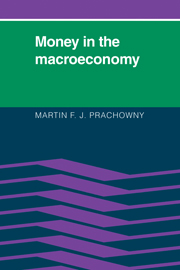Book contents
- Frontmatter
- Contents
- List of charts, figures, and tables
- Preface
- List of symbols
- 1 The roles of money and monetary policy in the macroeconomy
- 2 A model of the macroeconomy
- 3 The new classical model: the case against stabilization policy
- 4 The institutionalist model: the case for stabilization policy
- 5 The demand for money
- 6 The supply of money
- 7 The monetary mechanism
- 8 U.S. monetary policy and the dilemma of stagflation
- 9 A model of an open economy
- 10 Managed exchange rates and monetary policy
- 11 Monetary policy in Canada and its macroeconomic consequences
- 12 Improving the monetary policy apparatus
- Index
4 - The institutionalist model: the case for stabilization policy
Published online by Cambridge University Press: 26 October 2011
- Frontmatter
- Contents
- List of charts, figures, and tables
- Preface
- List of symbols
- 1 The roles of money and monetary policy in the macroeconomy
- 2 A model of the macroeconomy
- 3 The new classical model: the case against stabilization policy
- 4 The institutionalist model: the case for stabilization policy
- 5 The demand for money
- 6 The supply of money
- 7 The monetary mechanism
- 8 U.S. monetary policy and the dilemma of stagflation
- 9 A model of an open economy
- 10 Managed exchange rates and monetary policy
- 11 Monetary policy in Canada and its macroeconomic consequences
- 12 Improving the monetary policy apparatus
- Index
Summary
INTRODUCTION
To a new classical macroeconomist the principal guiding light is equilibrium. Equilibrium is in everyone's best interest and therefore each of us will try to achieve it. To Robert Barro the identification of equilibrium with optimality is derived from his belief that the equality of supply and demand “implies that … the private market manages to exhaust trades that are to the perceived mutual advantage of the exchanging parties.”
Underlying this belief is the perception that all markets are organized as auction markets, clearing at almost every instant in time, and that prices determined in these markets provide the participants with the signals that allow them to respond to changing conditions in ways that maximize their individual benefits as well as those of society as a whole. In such a world, other institutional arrangements do not make sense since they cannot improve on the results available from a complete set of auction markets. There is no room in the analysis for the influence of such institutions as labor unions and union contracts. If unions do not disrupt equilibrium, they are tolerated but irrelevant; if they do cause disequilibrium in the labor market, they will be eliminated by a new institutional arrangement for setting wages that does not produce this undesirable result. Nevertheless, we observe markets that are emphatically not auction markets.
- Type
- Chapter
- Information
- Money in the Macroeconomy , pp. 99 - 124Publisher: Cambridge University PressPrint publication year: 1986



